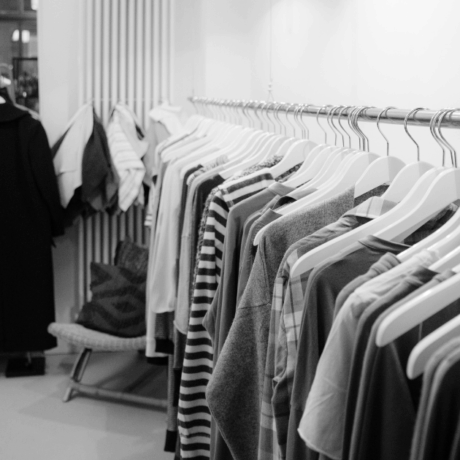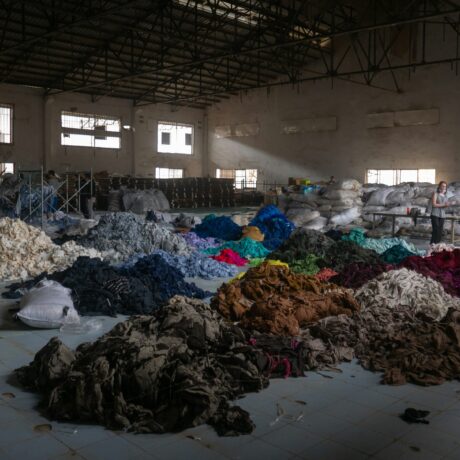Supplier led, brand supported: Experts discuss the green transition
In July, we launched our eighth edition of the Fashion Transparency Index, a tool we use to incentivise the world’s largest fashion brands and retailers to disclose more information about their social and environmental policies, practices and impacts, in their operations and supply chain.
The climate crisis is growing in intensity and urgency, yet we are still not seeing sufficient action from the fashion industry to address its role in exacerbating this crisis. This is why, this year we introduced a new indicator to understand major brands’ reliance on coal. Few brands (6%) disclose the proportion of their supply chain that is powered by coal and which geographic regions are still reliant on fossil fuels, painting an unclear picture of the scale of the problem we are facing. How can brands uphold their decarbonisation commitments if they can’t, or won’t, disclose how much coal they are using to begin with?
Another new indicator we introduced this year looks at brands’ investment in decarbonisation, to help us understand what actions brands are taking to actively support their suppliers in their green transition. The green transition refers to the changes that will achieve sustainable production so that the fashion industry no longer endangers the planet, changes such as switching to renewable energy and reducing the reliance on fabrics derived from fossil fuels. Disappointingly, only 9% of major fashion brands disclose their investment in decarbonisation, which raises the question; if brands aren’t investing in their sustainability commitments, who is?
To understand this issue further, we invited a range of industry experts and stakeholders to discuss the green transition, to give insight on how brands can prepare for this shift and how they can support their suppliers throughout the process. Here, you can explore some viewpoints featured in the Fashion Transparency Index 2023.
DECARBONISATION REQUIRES HONESTY, ACCOUNTABILITY AND ACTION
RUTH MACGILP
Fashion Campaign Manager, Action Speaks Louder
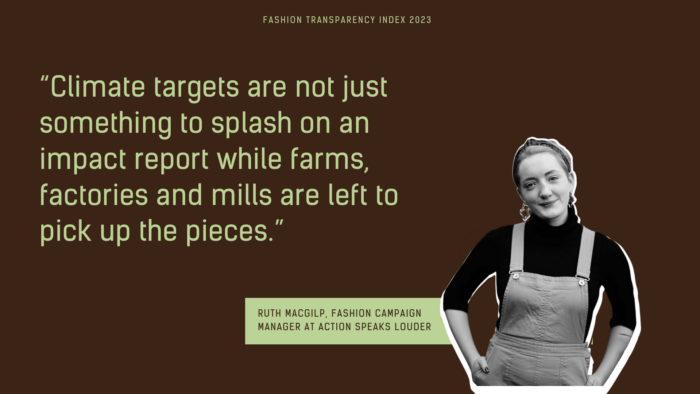
According to the Apparel Impact Institute, the majority of greenhouse gas emissions that fashion brands are responsible for are produced in their supply chain, concentrated at the material production and processing stage. This means that, while it’s promising to see some brands in this years’ Index committing to renewable energy in their own operations through RE100, without action to build or procure local and additional wind and solar power at the manufacturing level, the fashion industry will fail to meet its climate targets. At Action Speaks Louder, we close this do-say gap by mobilising communities who are harmed by corporate greenwashing. More often than not, we find that brands’ sustainability teams are blind to the reality of what it will take to reach their own climate targets: a total overhaul of the energy system that powers their supply chains. To shift the dial, we need to see bold, public facing commitments to build and procure clean, renewable energy.
“Despite increasing media attention on multi stakeholder initiatives, summits, pacts and charters, fashion’s carbon footprint continues to grow. Meanwhile, not one brand in the Index is disclosing an absolute reduction in energy consumption. So do commitments even matter anymore? Of course, targets alone are not enough. We need transparency on the actions taken to reach targets and robust accountability mechanisms for false sustainability claims.”
Staggeringly few brands disclose the energy mix in their supply chain, details on renewable energy procurement or even what constitutes their scope 3 emissions, making it impossible to scrutinise the feasibility of their climate commitments and sustainability claims. This dangerous lack of transparency leaves room for loopholes and false solutions such as biomass combustion, carbon offsetting and renewable energy credits that allow emissions-as-usual to continue. Like many issues explored in the Index, the challenge of decarbonisation is underpinned by a deeply flawed power imbalance between buyers and suppliers. Climate targets are not just something to splash on an impact report while farms, factories and mills are left to pick up the pieces. Instead, implementation of a successful decarbonisation strategy requires providing the financing, technical assistance and policy tools that allow suppliers to invest in the most effective solutions. Asia Garment Hub calls this approach ‘supplier led, brand supported’.
“Climate targets are not just something to splash on an impact report while farms, factories and mills are left to pick up the pieces.”
Brands tell us that the road to 100% renewable energy isn’t 100% clear. But this isn’t true. The clean technologies are all commercially available if big fashion puts the spending power behind them and commits to transparency about their progress. Those brands which don’t, but continue to claim they have climate credentials, will lose the trust of their customers and broader civil society.
WE STAND HERE WILLING AND READY TO MAKE THE TRANSITION BUT WHAT ARE THE INVESTMENTS NEEDED FOR A SUSTAINABLE ECONOMIC AND ENVIRONMENTAL FUTURE?
ALIA LODHI
Director, Inter Market Knit (pvt), Ltd. Lahore, Pakistan
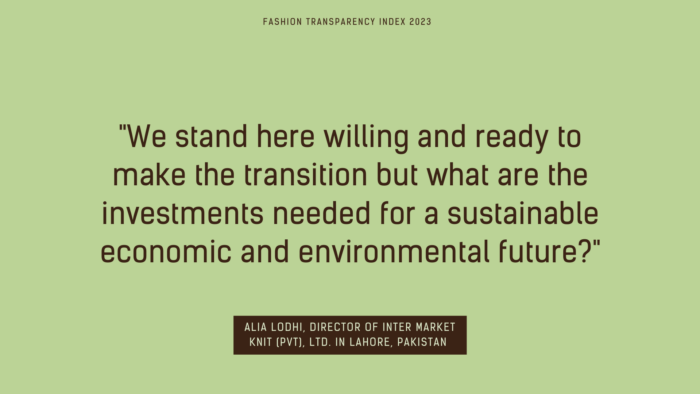
In our journey we have relied on our brand partners to lead the way forward and guide us. Traditionally, our responsibility has been to follow brands’ supplier codes of conduct and the United Nations United Nations Guiding Principles on Business and Human Rights diligently, strongly believing that they serve the best interest of all stakeholders. These guidelines were developed by various organisations with a global perspective encompassing everything from production system development to sustainable wage disbursement, health and safety and social responsibility. We have been engaged in calculations on how each of these systems impact the bottom line of our business. It really did work for us, but this new definition of responsibility – making the green transition demands a paradigm shift – perhaps even a new definition of a business entity!
The SDGs have set the stage for challenging current world views and opening the door for new legislations which could have near term effects on green transition. We have seen that an increasing number of brands, especially in Europe, are willing to understand the on-the-ground realities of the Global South. Could the first success story be of how a small manufacturer in the Global South catalysed change? How can those with more resources create conditions that make the green transition viable and attractive? How can the world’s largest fashion brands and retailers enable manufacturers in the textile industry to play an active and a more effective role in green transition? We stand here willing and ready to make the transition but what are the investments needed for a sustainable economic and environmental future? This year’s Global Fashion Transparency Index asks brands, for the first time, if they disclose their level annual investment in decarbonisation, which includes financing the costs of green transition. Fashion Revolution’s research finds that 91% of brands reviewed do not disclose this information, which signals that financing the transition is not a priority for them, though it is an expectation on us to be more sustainable.
With an increased radius of responsibility reaching far beyond the realms of compliance, we want to foster stronger and long term partnerships, and promote absolute transparency. We crave for a deep understanding from our partners of the challenges that small manufacturers like us are challenged with regarding green transition in the face of market driven prices. In my business, we strive to create awareness that leaving a better world for the future generations requires a clear understanding of the impact of our actions with and without these transformative steps. While we believe that investment and taking responsibility for implementing changes successfully, is a shared burden between the brands and their suppliers, small manufacturers like ourselves can benefit by showcasing our efforts to help win future investments from brands. This kind of showcasing can be mutually beneficial and can redefine the future of the textile industry.
BEYOND REPORTING AND TARGETS, WE ALSO NEED AN ACCELERATION IN ACTION
PAULINE OP DE BEECK
Environmental Portfolio Lead, Apparel Impact Institute
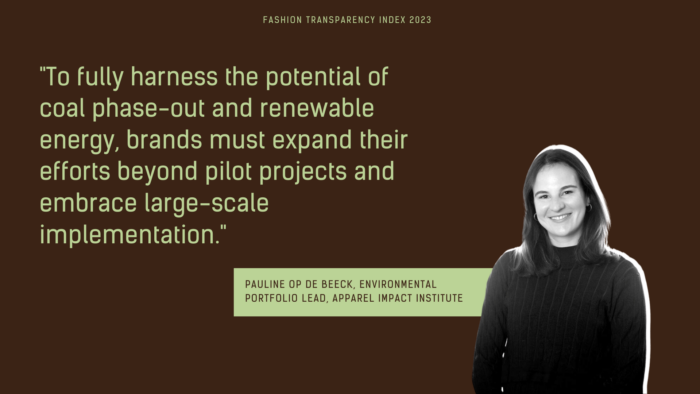
As we approach the halfway mark to 2030, the increase in detailed scope 3 disclosure, setting of near & long-term targets, and published progress against them is welcome. However, brands reporting on these indicators still represent less than half of the sector well below what is needed for 1.5C alignment by 2030. We need foot-printing and targets set to be at 100% by 2025.
One of the most encouraging improvement indicators is the increase in environmental risk and impact reporting linked to financial statements: 22%, up from 13% in 2022. This demonstrates that more brands are seeing the relationship between their business’ viability and the need to align to net zero. This understanding catalyses deep decarbonisation efforts
While we celebrate these advancements, it is important to acknowledge areas that still require attention. A small fraction of brands (6%) disclose the proportion of their production powered by coal, and only 9% report supply chain renewable energy. To fully harness the potential of coal phase-out and renewable energy, brands must expand their efforts beyond pilot projects and embrace large-scale implementation. This entails mapping suppliers’ energy sources, setting specific targets, and formulating comprehensive plans to achieve them. Additionally, we must come together as an industry to address shared challenges.
A key step lies in establishing a common understanding of the most viable alternative sources for thermal energy and electricity, taking into account country- and facility specific contexts. Not all alternatives will be equally feasible from a financial or technological standpoint. By fostering collaboration and knowledge exchange, we can identify the optimal energy solutions that strike a balance between environmental impact and practicality. Another critical factor is the evolution of policy frameworks in garment producing countries. We have seen promising examples, such as in Bangladesh, where brands have actively engaged with policymakers to develop regulations that facilitate renewable energy deployment. By replicating these efforts in other countries, we can accelerate facility-level installations and explore alternative avenues such as corporate Power Purchasing Agreements.
The commitment of brands to their targets can be truly measured by the level of transparency regarding their green investments. While the current disclosure rate stands at less than 9%, we believe this indicator will increase dramatically by 2025. Targets must be accompanied by robust net-zero transition plans that outline the associated costs. With just 6.5 years left to halve emissions, we have to mobilise action and secure the required capital.
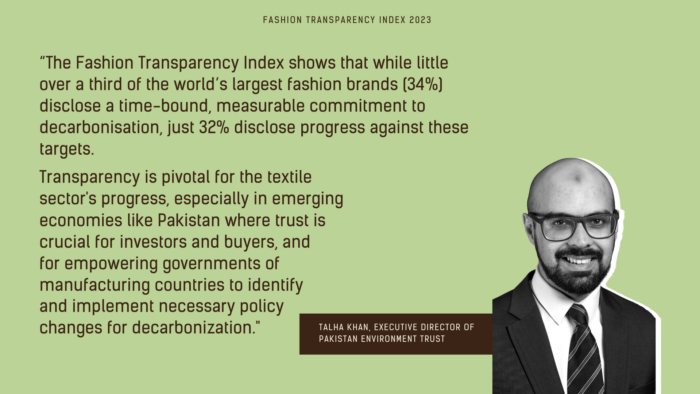
You can read more about climate change, biodiversity and the green transition in the 2023 edition of the Fashion Transparency Index.
Header image by Nuno Marques on Unsplash




